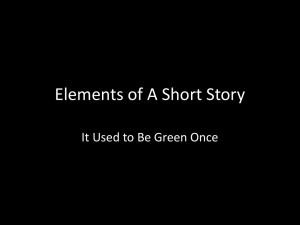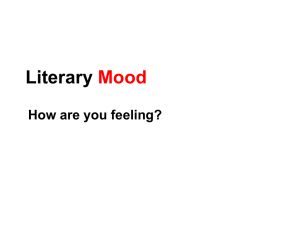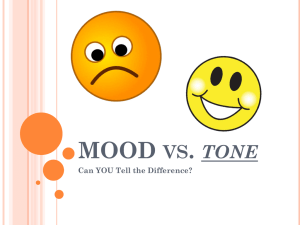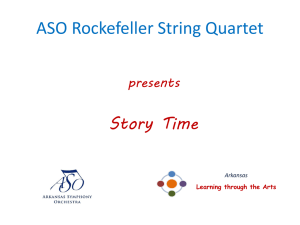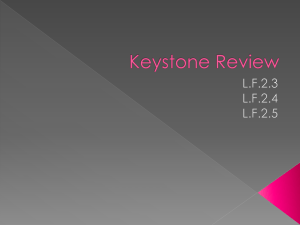Exercise-Mood
advertisement
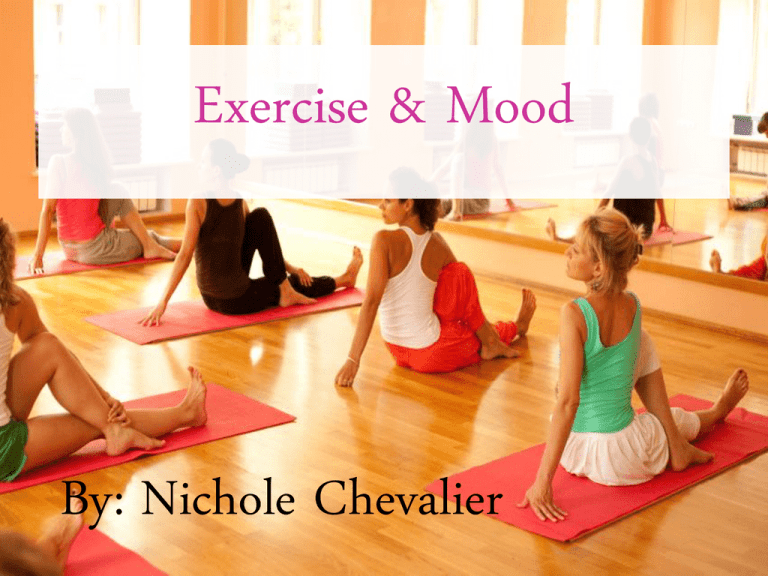
Exercise & Mood By: Nichole Chevalier Mood enhancement persists for up to 12 hours following aerobic exercise: A pilot study. Perceptual And Motor Skills Sibold, J. S., & Berg, K. M. (2010) Hypothesis If one participates in moderate intensity aerobic activity then their mood will be positively effected for as long as 12 to 24 hours post activity. Variables Independent - Level 1: No Exercise (control group) - Level 2: Exercise Group Dependent -Scores reported on the mood inventory Participants 48 Healthy College Students between the ages of 18-25 -35 Females -13 Males Recruited through signage posted in buildings and residence halls on a college campus. Exclusions… -Anyone with psychological disorders -Anyone using psychoactive drugs -Anyone with a history of physical illness or injury -Anyone under the age of 18 or over the age of 25 Procedure Part 1: Physical Readiness Assessment -Readiness for physical activity was tested through the PAR-Q -Aerobic capacity was tested using a Fitmate Pro metabolic system and a Polar Vantage XL heart rate monitor -Participants completed an exercise test on a stationary cycle -Based on the results of a self-report of activity level participants were assigned to different exercise conditions -Peak heart rate was measured and used to estimate the heart rate target for the exercise intervention -A lower to moderate intensity was selected Procedure (cont.) Part 2: Assessment of mood -Mood was assessed using the Profile of Mood StatesBrief Form -30 inventory items with subscales -rated from 0-4 -Scores are calculated by adding the totals of the five negative moods and then subtracting them from the Vigor score -Participants were asked to complete the inventory in respect to how they felt “right now” Procedure (cont.) Part 3: Physical Assessment -Participants put on a heart rate monitor and a silicone facemask which was attached to a metabolic analyzer -Cycling rules and criteria were reviewed with the participants -There was a two minute warm-up -Resistance was added incrementally every minute -Perceived exertion was recorded every two minutes -Following the test participants were allowed to cool down until their heart rate reached a normal level Procedure (cont.) Part 4 -Participants came to the lab no less then 3 days after the first visit -At the second visit participants completed the mood inventory and were assigned to either an exercise condition or a control group -Only one participant was allowed in the lab at a time -Participants in the control condition sat quietly in the lab for 20 minutes -Participants in the exercise condition cycled for 20 minutes on a stationary bike -Immediately after the exercise or control condition the mood inventory was completed -The subjects were then asked to complete the inventory 1,2,4,8,12, and 24 hours post exercise -The times were written on the inventory and an e-mail reminder was sent to subjects prior to the times -Participants handed in the inventories the next day at the lab -They received a modest financial compensation for participation and return of the completed inventories Results -The group that participated in aerobic exercise had a significantly lower mean total mood disturbance score -Significant differences were seen immediately following exercise -Sex or fitness level had no effect on mood -Moderate aerobic exercise resulted in acute improvements in overall mood What does this mean? • Moderate physical exercise helps to improve one’s overall mood • Exercise can be beneficial to one’s mental health • People who are feeling stressed or dealing with negative emotions should try to exercise • It is important to incorporate exercise into our schedule as often as we can The mood-enhancing benefits of exercise: Memory biases augment the effect. Anderson, R. J., & Brice, S. (2011) Hypothesis Participants who exercise will exhibit actual mood benefits when comparing pre- and post-exercise reports of current mood in addition to having an enhanced perception of mood benefits post-exercise. Variables Independent - Level 1: No Exercise (control group) - Level 2: Exercise Group Dependent -Participant’s Mood Participants 40 Regular Exercisers: At least two 30 minute sessions per week -20 Females -20 Males Participants we between the ages of 18-25 They were recruited by sampling various sports clubs in the North East of England Procedure -Participants were informed the study was examining the impact of various activities on mood -Prior to activity the participants completed ISP of Mood States Questionnaire -Participants in the exercise condition had to jog lightly for 10 minutes -Participants in the non-exercise group had to complete a word search for 10 minutes -Participants completed the tasks in groups of 2-3 -Immediately after the activities both groups completed the ISP -Half of each group was then asked to complete the ISP a second time -The first time they reported their current mood -The second time they were asked to recall their mood pre-activity -Participants were asked to try and not remember the responses they put on the original ISP but to remember how they felt before the activity -All conditions took place when the weather was fine and dry and distractions were minimized Results -There was significant mood enhancement in the exercise group compared to the non-exercise group -Participants retrospective estimates of pre-activity mood state were favorably distorted with respect to mood enhancement -Recalling past affective states only altered the mood of the subjects in the exercise condition What does this mean? • Exercise affects mood in a positive way • Post exercise the mood of someone at the time they recall something effects how they recall the information -If you are happy you may favorably distort information -Post exercise people have a memory bias Expectations can make us believe that things are happening even when they are not (placebo effect) Questions?


